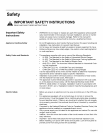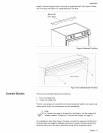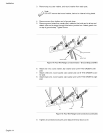
Installation
®
4" (10.2cm)
rain.
1
30" (76.2 cm)
'_ min. centered
30" (76.2 cm) min.
no clearance required
(12 mm clearance required in Canada)
®
4" (10.2cm)
min.
Figure 7: Cabinet Preparation
Prepare Walls and Floor
Countertop Requirements
Mounting Requirements
Required Clearance I
From cooktop to materials above: There must be a minimum clearance of 30
inches between the top of the cooking surface and the bottom of an unprotected
wood or metal cabinet. See Figure 7: Cabinet Preparation.
24 inches is acceptable when the bottom of the wood or metal cabinet is protected
by (a) not less than 1/4" of flame retardant material which must be covered with
(b) not less than No. 28 MSG sheet metal, 0.015 inch stainless steel' or 0.024 inch
aluminum or copper.
From range walls to adjacent materials: See Figure 7: Cabinet Preparation. No
clearance is required from unit walls to adjacent vertical combustible walls on
rear, right or left.2
Clearance from range top to adjacent vertical walls must be at least 4".
Note:
Some cabinet finishes cannot survive the temperatures allowed by
safety standards, particularly self-cleaning ovens; the cabinets may
discolor or stain. This is most noticeable with laminated cabinets.
Seal any holes in the walls or floor. Remove any obstructions (extra electrical or
gas connections, etc.) so that range will rest against wall properly.
Countertops must be smooth and level.
Install Anti-Tip Bracket
1. Measure to locate bracket position as shown in See Figure 8: Anti-Tip
Bracket.
1. Instructions were determined using standard American cabinets. Standard base cabinets mea-
sure 36" high x 24" deep. Cabinets over the cooking surface and cabinets adjacent to those over
the cooking surface measure 13 inches deep from backwall. If nonstandard cabinets are used,
care should be taken to alter dimensions accordingly.
2. In Canada, a clearance of 12 mm from range sidewall to cabinet is required.
English 9


















